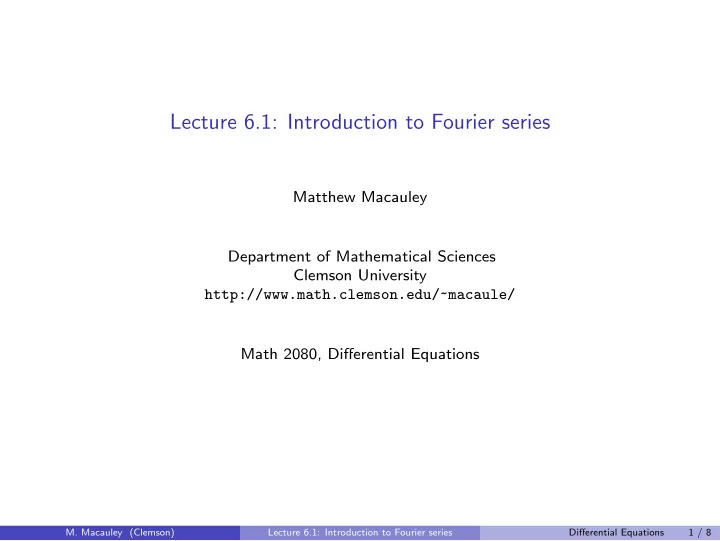

Lecture 6.1: Introduction to Fourier series Matthew Macauley Department of Mathematical Sciences Clemson University http://www.math.clemson.edu/~macaule/ Math 2080, Differential Equations M. Macauley (Clemson) Lecture 6.1: Introduction to Fourier series Differential Equations 1 / 8
Introduction Motivation Every “well-behaved” periodic (think: sound wave) function can be decomposed into sine and cosine waves. We’ll learn how to do this. An analogy R n is a set of vectors. We can freely: add & subtract vectors, multiply vectors by scalars, measure the lengths of vectors; || v || := √ v · v , v · w measure the angles between vectors; ∡ ( v , w ) := cos − 1 � � , || v || || w || project vectors onto unit vectors: Proj n v := ( v · n ) n . M. Macauley (Clemson) Lecture 6.1: Introduction to Fourier series Differential Equations 2 / 8
An analogy Questions � 1 � � 0 � � 4 � The standard unit basis vectors of R 2 are e 1 = and e 2 = . Let v = . 0 1 3 1. How long is v in the x -direction? 2. How long is v in the y -direction? 3. How long is v in the “northeast direction”? M. Macauley (Clemson) Lecture 6.1: Introduction to Fourier series Differential Equations 3 / 8
An orthogonal basis of R n Definition � 1 , i = j A set of vectors { v 1 , . . . , v n } is orthonormal if they satisfy: v i · v j = 0 , i � = j . M. Macauley (Clemson) Lecture 6.1: Introduction to Fourier series Differential Equations 4 / 8
The vector space of periodic functions Let P 2 π be the set of 2 π -periodic piecewise continuous functions: � � P 2 π = f : R → R | f ( x + 2 π ) = f ( x ) , f is piecewise contin. Definition The inner product (“generalized dot product”) on P 2 π is defined to be: � π � f ( x ) , g ( x ) � := 1 f ( x ) g ( x ) dx . π − π M. Macauley (Clemson) Lecture 6.1: Introduction to Fourier series Differential Equations 5 / 8
The vector space of periodic functions Amazing fact � π With respect to our inner product � f , g � := 1 − π f ( x ) g ( x ) dx on P 2 π , the set π � � 1 cos x , cos 2 x , cos 3 x , √ 2 , . . . B 2 π = sin x , sin 2 x , sin 3 x , . . . is an orthonormal basis for P 2 π ! M. Macauley (Clemson) Lecture 6.1: Introduction to Fourier series Differential Equations 6 / 8
Formula for the Fourier coefficients Theorem Let f ( x ) be a piecewise continuous 2 π -periodic function. We can write ∞ f ( x ) = a 0 � 2 + a n cos nx + b n sin nx , n =1 where � π a n = � f ( x ) , cos nx � = 1 f ( x ) cos nx dx π − π � π b n = � f ( x ) , sin nx � = 1 f ( x ) sin nx dx . π − π M. Macauley (Clemson) Lecture 6.1: Introduction to Fourier series Differential Equations 7 / 8
Periodic functions with other periods Remark Let f ( x ) be a piecewise continuous 2 L -periodic function. We can write ∞ f ( x ) = a 0 � a n cos( π nx L ) + b n sin( π nx 2 + L ) , n =1 where � π L ) � = 1 a n = � f ( x ) , cos( π nx f ( x ) cos( π nx L ) dx L − π � π L ) � = 1 b n = � f ( x ) , sin( π nx f ( x ) sin( π nx L ) dx . L − π M. Macauley (Clemson) Lecture 6.1: Introduction to Fourier series Differential Equations 8 / 8
Recommend
More recommend